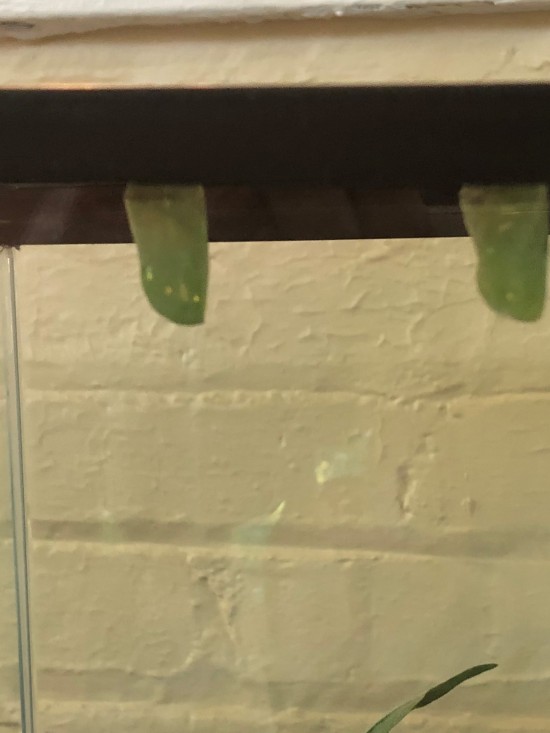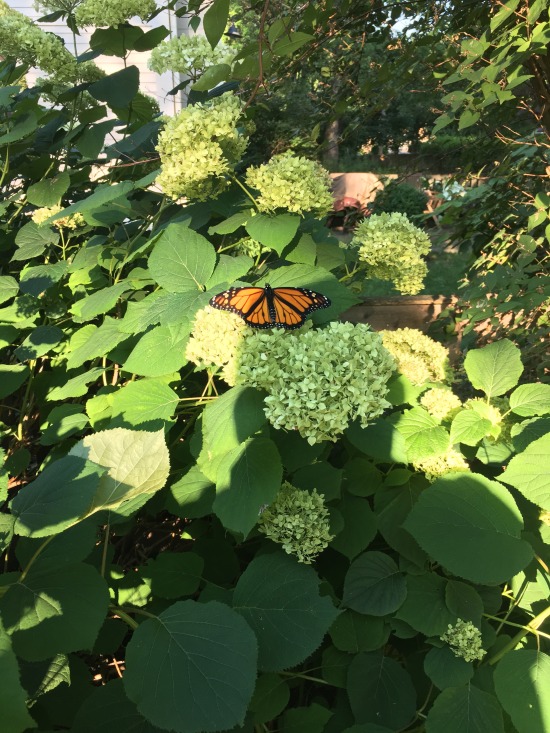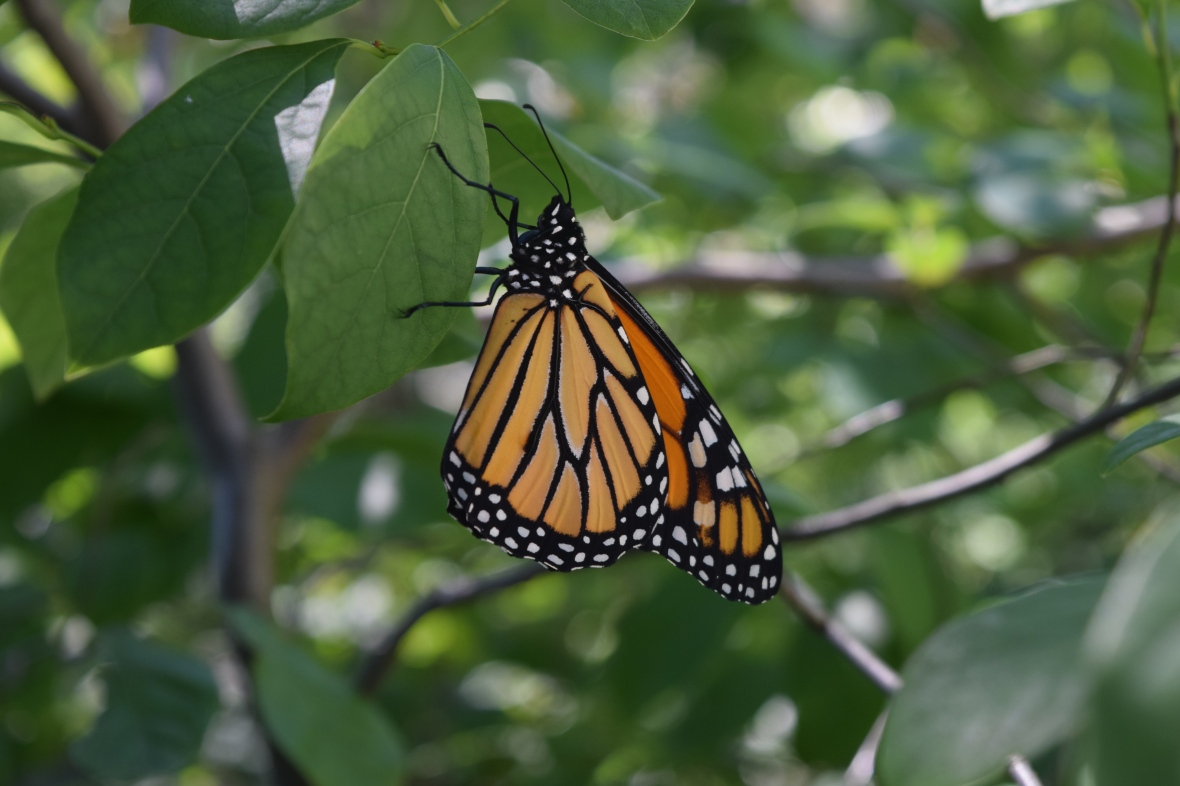Our First Home Grown Monarch Butterflies
So Judy and I just raised our first Monarch butterflies to adulthood. We were nervous about trying, but then we read that only about 5% of Monarch caterpillars in the wild make it to adulthood. We figured we could do better than that.

We brought in four caterpillars that we found on our Butterflyweed (Asclepias tuberosa). For this first effort we used an old-fashioned glass terrarium. We found out later that a mesh terrarium works better, so we’ll use that the next time. They’re pretty inexpensive.
It takes up to two weeks for Monarch caterpillars to turn themselves into chrysalids, and in that time they generate massive quantities of caterpillar poop, also known as frass. It’s important to keep the terrarium clean, which means getting rid of the frass each day. We used a lining of moist paper towels, which made cleaning a little easier. You also have to add fresh Milkweed stems every day, so that the caterpillars don’t run out of food.

Sadly only two of our caterpillars made a successful transition to chrysalids. Of the others, one got into position but only made it halfway through the transformation, then died. Another one completed the transformation, but attached itself to the paper towels at the bottom of the terrarium. The two successful chrysalids attached themselves at the top.
Losing two of the caterpillars was disappointing. Still, 50% is better than 5%.

It takes 10-14 days for an adult Monarch to emerge from the chrysalis. Judy and I had to travel for our jobs just as we were reaching the critical point. Fortunately my neighbor Matt and his 5-year old daughter Julia were willing to check the chrysalids ever morning and evening. Such good neighbors!
Sure enough, the day before I returned Matt and Julia found an adult Monarch fluttering around inside the terrarium. They took the terrarium outside, opened it up, and watched the Monarch take wing. Matt took a few pics with his phone and texted them to me. I was excited, though I also felt a bit like I had missed being present at the birth of my first child.

After leaving the terrarium the monarch spent a few minutes basking on the Smooth Hydrangea (Hydrangea arborescens).
The next afternoon I got home. I rushed to the terrarium and found an adult Monarch sitting on the glass floor of his temporary home. I placed my finger near his head, and he crawled right on. New adults take up to a day to dry out their wings and otherwise acclimate to their new life stage. I wasn’t completely sure this guy was ready to take off.

Despite this, I carried him outside. A few steps beyond the door and away he went, landing on a nearby Spicebush (Lindera benzoin).
This post is not meant to be a guide to raising Monarchs indoors. For that you should check a reputable source, like Save Our Monarchs.
Having done this once, we are eager to try again. Unfortunately, we’re not finding any caterpillars in the garden, though there are always a few adults around. I’m optimistic that we’ll find a few before the next migration has finished passing through this area.
Let’s close with a little Monarch caterpillar video that Judy took. Until next time, think about places where you can plant more Milkweed for the Monarchs.





That is amazing! Well done to you and your neighbour for being successful midwives!
Thanks. I was pretty excited, as were the neighbors.
Kudos to you and your neighbors on the Monarchs reaching adulthood. Too bad you didn’t get to see them actually emerge, but they certainly are beautiful when they are first emerged and pristine.
There’s always next time. Just have to keep an eye out for more caterpillars.
Congratulations on the birth of the Monarchs … quite an achievement. I have once seen a butterfly emerging & it was fascinating … nature at ts finest. I hope you can do this every year.
Me too. Actually, I hope we find some more caterpillars this year.
Looks like two males, though it’s harder to tell by looking at the underside of the wing. In the first and second photos it is easy to see the telltale dot on the bottom wings that indicates a male. A female doesn’t have the dots but the black wing veins are thicker, giving her an overall darker appearance.
I think you’re right – two males. Now I have many sons to support me.
Amazing 🙂 Nature at its best ! keep glittering !!!
Thanks.
Very cool you two! The video is fun.
For some reason those caterpillars remind me of clowns.
Well done! I’ve thought about trying my hand at being a monarch foster parent, but am still too tentative. That five-year old will have a story to tell when school starts.
She was pretty excited.
Wow–great story and cheers to you and Judy for attempting to raise butterflies!
Thanks!
What a wonderful story! On so many levels, from the neighbors who were willing to help to the birth of these beauties. Once upon a time, in Maine, there were so many monarchs that it was easy to gather a few caterpillars, put them in jars, and watch the metamorphosis. My memory might be unreliable, but I recall our success rate being 100 percent. Anyway, bravo to you and Judy.
Thanks. I hope that our success rate improves in the future.
Well Done!
Thank you!
So exciting! We raised a few butterflies last year but this year, since we have the kitten, we decided not to as we prefer to keep the cages inside and it may be too much of a temptation for her. I think only one of the butterflies we reared was from a caterpillar we found – for the rest, I looked for eggs on the milkweed in our garden, which were fairly easier to find.
I find the eggs to be really difficult to find. I imagine it would be easier to start with the eggs.
Congratulations! I have never found any monarch caterpillars on my milkweed, so I think I will have to learn to spot eggs (assuming there are any). Thanks for the how-to link!
Be patient. The caterpillars may make their appearance.
What a wonderful event. You’re right — 50% beats 5% every time, and I suspect if you try again you’ll be even more successful. I don’t think I’ve ever found a Monarch egg, but I’ve never gone looking with any dedication. I know several people who have moved past enthusiastic about raising them to obsessing a bit — but it’s a very friendly and cheerful obsession, and not at all annoying. They have great success, too.
Yes, there is a FB page called The Beautiful Monarch that has 25,000 members and the people on it are completely obsessed. Some of them raise hundreds of butterflies every year.
We have fields full of milkweed but few monarchs, and I haven’t seen a caterpillar in years.
That’s very sad.
Congratulations. And many more
I hope there are many more!
That is wonderful! Congratulations! Sometimes the ones that pupate on their sides survive, so if that happens again, you can wait and see if it will successfully emerge. Isn’t it fun to watch them grow and change and become butterflies?!
I think I would have to move the chrysalis. Someone else told me I could it re-attach to another surface. It is definitely lots of fun. I would get up in the morning and start talking baby talk to the caterpillars.
When my grandkids were young, we did this several years. It is always a thrill. 🙂
Wish I had known about it early enough to do it with our kids when they were little.
I never would have guessed that 95% do not make it to adulthood! When I was in grammar school, we brought a few chrysalids that we found in the landscape into our classroom, and they all developed into butterflies of one sort or another. Of course, I do not know what happened to them after they flew away.
The low survival rate is because of the many predators, especially other insects.
Very cool! Several years ago when my kids were little we did this. It was really neat to get a close view of their life cycle. I’m sure your friend’s daughter had a ball babysitting your butterflies!
She did seem pretty excited.
Fascinating. I haven’t seen any caterpillars in my yard for a few years, period. I used to get them. I’m thrilled you are able to do this!
Keep looking. You may see some yet.
Thank you for your Monarch Nursery! Several years ago, milkweed appeared in my garden and the Monarchs followed, laid eggs, and I have been raising caterpillars to butterflies every since. It is so much fun and rewarding. Just this morning, a butterfly emerged from its chrysalis! And I have five more waiting for their turn. It never gets old — I love watching the miracle of transformation. In my area of Minnesota, it has been a good year for Monarch sightings and egg laying. Hopefully, it will continue! Continued good luck to you!
Thank you so much! Judy and I really enjoyed this experience and we hope to continue. We’re still trying to find more caterpillars, though there are several adults flying around the garden every day.
A beautiful post, Jason! It is nice to see their life cycle, and their striking caterpillars moving about. I have not seen Monarchs where I am, mainly swallowtails.
There are West Coast Monarchs with their own migration, but maybe they don’t come to your part of Oregon.
Well done! Such good neighbors!
Yes, we are lucky in our neighbors.
What a fascinating post! Wow! Well done, you two and the neighbours! Congratulations, fifty per cent is fantastic! I do hope more people give this a go! I certainly would.xxx
I’m sure you would excel at it, given all your experience.
Well done I say!
Thanks!
I brought over loads of swamp milkweed from my other garden and added 30 orange milkweed plants to the prairie I’m planting on my slope. I may try raising monarchs, too! Hooray for your success!
The Monarchs will love you! By the way, I thought of you when I saw this article: https://www.washingtonpost.com/local/virginia-politics/in-this-subdivision-lawns-must-be-mowed-but-what-about-meadows/2018/08/03/a18e03bc-966c-11e8-810c-5fa705927d54_story.html?utm_term=.baab3328dbfe&wpisrc=nl_most&wpmm=1
Sorry Jason, but it was not the butterfly which caught first my attention in this post but your plant Asclepias tuberosa. I planted it this year in my garden. I am not really sure if it is frost-resistant or need a winter protection? Of course also the butterfly looks nice.
A. tuberosa is very hardy! No winter protection needed. However, it doesn’t like wet soil, so make sure it’s sited someplace well drained.
A friend started raising Monarchs a few years back and has enjoyed the project since. You were very successful!
Thanks! I’ve noticed once people start, they can become obsessed!
This year was our first year with monarch butterflies too. I think it’s the weirdest, most beautiful thing I’ve ever seen in my life. We likewise had some successes and some tragedies. Just for future reference, if the chrysalis is intact you can move it to a better location: you just loosen the silk pad from the surface it’s on, and then you can use scotch tape to tape the silk pad (allowing the chrysalis to hang free) to a better surface.
It’s hard not to think of the chrysalis as extremely fragile. Next time I’ll rescue that one chrysalis and put it somewhere safe.
I’ve watched a few Swallowtail worms turn to butterflies in my garden, but usually the worms are eaten by birds or bees (that was creepy) before they can change. Too bad you missed the flight to freedom!
I haven’t tried Swallowtail caterpillars yet, but sometimes we see them on the fennel, so maybe I’ll give them a try also.
By the way, I tried to comment on your blog but I think I ended up in the spam folder.
Hello Jason, you’ve already made it ten time more successful than in the wild on your first go and I love the light coming through the orange wings! It’s a shame you missed the main event, but there’s always next time!
Definitely looking forward to next time!
Great! That’s a wonderful thing to watch, I presume, and now you have some experience you might get even better results next time. So glad you managed to help two survive. 🙂
I think we will have better results in future. It was a learning experience.
Good for you. I put in a new planting area this spring and went searching for milkweed at the local nurseries, but this year no one was selling it. Maybe next year.
I usually order it online.